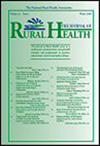Rural nonprofit hospital community benefit and financial assistance spending: A call for greater reporting transparency
Abstract
Purpose
US nonprofit hospitals must provide community benefits including financial assistance to be tax-exempt. Rural residents particularly benefit from financial assistance because they have higher medical debt on average. The Internal Revenue Service allows nonprofit hospitals that are members of health systems to report expenditures for their entire system (group returns) rather than for individual hospitals. Our study examined how (if at all) rural nonprofit hospitals filing group returns are different than those filing individual returns.
Methods
We used 2021 data extracted from Community Benefit Insight and the American Hospital Association for 100 rural nonprofit hospitals in Wisconsin and Minnesota. We conducted bivariate analyses examining differences in mean total community benefit spending and mean financial assistance spending as a percentage of total operating expenses for hospitals filing individual versus group returns. We conducted multivariable regression models examining the association of filing group returns and individual returns with community benefit spending and financial assistance spending.
Findings
Bivariate analysis revealed significant differences between group return hospitals and individual return hospitals in spending on community benefits (5.81% vs. 9.49%, respectively) and on financial assistance (0.36% vs. 0.71% respectively). Multivariable regression demonstrated filing group returns is significantly negatively associated with community benefit expenditures (β = –2.90, p < 0.05) and financial assistance expenditures (β = –0.31, p < 0.01).
Conclusion
In our sample, filing group returns was associated with less spending on community benefits and financial assistance. To understand this finding, researchers need data on individual hospital spending to increase transparency and accountability.

 求助内容:
求助内容: 应助结果提醒方式:
应助结果提醒方式:


